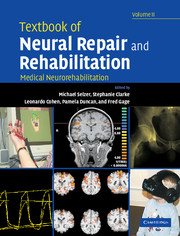Book contents
- Frontmatter
- Contents
- Preface
- Contributors
- Contributors
- Neural repair and rehabilitation: an introduction
- Section A Technology of neurorehabilitation
- Section A1 Outcomes measurement and diagnostic technology
- 1 Outcomes measurement: basic principles and applications in stroke rehabilitation
- 2 Human voluntary motor control and dysfunction
- 3 Assessments, interventions, and outcome measures for walking
- 4 Electromyography in neurorehabilitation
- 5 Functional neuroimaging
- Section A2 Therapeutic technology
- Section B Symptom-specific neurorehabilitation
- Section B1 Sensory and motor dysfunctions
- Section B2 Vegetative and autonomic dysfunctions
- Section B3 Cognitive neurorehabilitation
- Section C Disease-specific neurorehabilitation systems
- Index
- Plate section
4 - Electromyography in neurorehabilitation
from Section A1 - Outcomes measurement and diagnostic technology
Published online by Cambridge University Press: 04 August 2010
- Frontmatter
- Contents
- Preface
- Contributors
- Contributors
- Neural repair and rehabilitation: an introduction
- Section A Technology of neurorehabilitation
- Section A1 Outcomes measurement and diagnostic technology
- 1 Outcomes measurement: basic principles and applications in stroke rehabilitation
- 2 Human voluntary motor control and dysfunction
- 3 Assessments, interventions, and outcome measures for walking
- 4 Electromyography in neurorehabilitation
- 5 Functional neuroimaging
- Section A2 Therapeutic technology
- Section B Symptom-specific neurorehabilitation
- Section B1 Sensory and motor dysfunctions
- Section B2 Vegetative and autonomic dysfunctions
- Section B3 Cognitive neurorehabilitation
- Section C Disease-specific neurorehabilitation systems
- Index
- Plate section
Summary
Introduction
One of the fundamental principles of electrodiagnostic medicine is the assessment of the peripheral nervous system's ability to conduct an electrical impulse (Dumitru et al., 2002). Nerve conduction studies (NCs) and needle electromyography (EMG), are commonly referred to as electrodiagnostic or EMG studies. Electrodiagnostic studies play a crucial role in identifying disorders that affect the peripheral nerve, the dorsal root ganglia, the nerve root, or the anterior horn cell. Electrodiagnostic studies can also identify disturbances at the level of the neuromuscular junction and in the muscle. Additionally, EMG studies can provide useful information in disorders involving the upper motor neurons or disorders of volition as well as evaluating gait.
Thus, electrodiagnostic testing serves as an important diagnostic and prognostic tool when applied within the context of the clinical neurologic examination. A detailed, focused history and neurologic examination should serve as the template upon which one designs and performs the EMG study. Data acquired during the EMG study must always be interpreted within the clinical context because the same data may have very different interpretations depending on the clinical situation. An EMG study performed in isolation of the clinical context may provide little useful information.
Basic principles in EMG
The primary goals of the EMG study are to localize the lesion, characterize the underlying nerve pathophysiology, quantitate the severity of the lesion, and assess the temporal course of the disorder (Preston et al., 1998).
- Type
- Chapter
- Information
- Textbook of Neural Repair and Rehabilitation , pp. 48 - 55Publisher: Cambridge University PressPrint publication year: 2006

